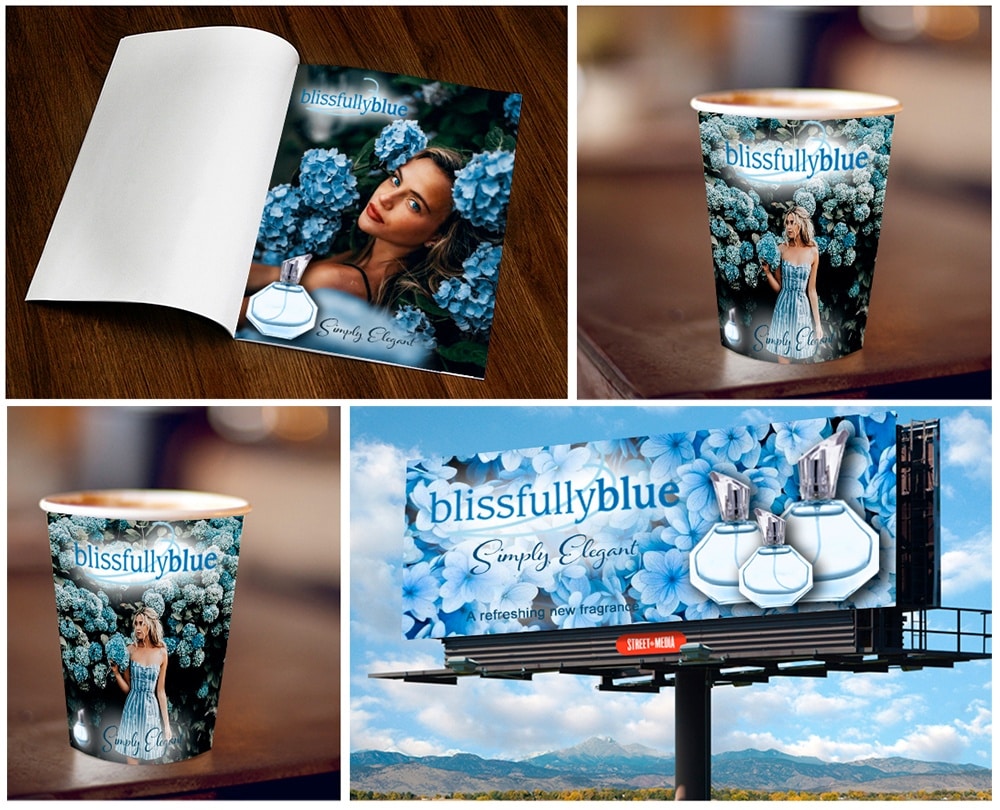ADV 201: Advertising Design I
Reach your target audience by design
Ready to put on your Madison Advenue shoes? In this online advertising course, you'll learn the principles of the advertising design from both a creative and a business perspective. Case studies from print, Web, and TV showcase advertising concepts at work: persuasion, color psychology and composition, copywriting and typography, and brand communication. Class projects include ads for newspapers, magazines, subways, and transit/outdoor applications, and a final project in which you create an entire ad campaign.
About This Course
Project-Based Learning
Learn to design ads and campaigns in a range of settings: Newspaper ad, outdoor ad, food industry ad, resort ad campaign, TV show promotion, cosmetic brand campaign.
What Skills Will I Develop?
Students in this course can expect to learn to:
- Develop an understanding of the history and evolution of advertising in America and the role of designers in ad agencies and the freelance world.
- Design a persuasive black and white newspaper advertisement, working with copy and typography to create an eye-catching design.
- Identify and apply principles for effective ad design in different media.
- Create two subway ads for a cell phone provider, exploring different approaches to advertising tone.
- Identify and apply design elements such as line, shape, and texture in advertising design.
- Identify and apply principles of composition and layout including space, rhythm, and depth in advertising design.
- Develop a consistent ad campaign using elements that differ based on season and placement.
- Explore and apply tips and techniques for writing ad copy and using typography to enhance the persuasive power of advertising.
- Design a billboard and bus shelter ad using typography to enhance a message.
- Develop an understanding of the ways in which human perception influences ad design.
- Develop a concept for ads in three different media, considering how to present the client's brand and the product's brand in each ad.
- Identify and apply principles for incorporating a brand into a single ad and applying a brand over an entire campaign.
- Draw lessons from case studies of ad campaigns and evaluate their effectiveness.
- Design an integrated advertising campaign using a fictional client's requirements and specifications.
What Software and Supplies Do I Need?
- Computer with a minimum internet connection speed of 512 kbps. Broadband is strongly recommended.
- Adobe Creative Cloud: Photoshop and Illustrator required. InDesign optional.
- Basic experience in graphic design and the software packages needed for this course.
Course Instructor(s)
The course is taught by the following instructor(s):
 Kristen Becker
Kristen Becker
Kristen Becker is an educator and a graphic and business designer specializing in e-commerce. With over 12 years of experience as an award-winning educator, Kristen has developed curriculum and taught courses in graphic design, multimedia, and e-commerce/marketing.
View all Faculty
Course Outline
Intro to Advertising
We begin the course laying a foundation for your ad design career. You'll trace the evolution of advertising in the United States, and learn about the different roles and departments in an ad agency. Thinking about going it alone? You'll look at some of the key attributes required for success as a freelancer. The fundamentals of form, function, and consumer behavior are discussed, as well as persuasion techniques such as motivation, organizing your message, communicating with images, tapping into connotations, associations, and context.
Designing for Advertising Media
Where does the ad designer place his work? This week kicks off with an overview of different advertising media (newspapers, magazines, outdoor/transit, Internet, television and beyond) looking at some of the unique demands of each medium. Following that, you'll study principles for effective ad design, including the role of concept and design, totality and integration, trendy concepts versus trendsetting ones, and the controversial topic of taste. The lesson wraps up with a discussion of tone: humorous, dramatic/informative, sexual, and scientific.
Color Psychology and Composition
How would you feel about a toothpaste ad in yellow and brown? In this session we will explore the critical role of color in advertising. You'll explore the basics of color psychology, the associations between a color and a mood or a feeling and look at how the effective use of color, in light effects, hue, values and intensities, contrast and temperature, can support the overall message of an ad. The second half of the lesson explores the psychology of composition, how design elements such as texture, line, shape, space, distortion, rhythm, and depth can contribute to an ad's effectiveness.
Copywriting and Typography
In advertisements, the written word should never be neglected. Excellent graphic design and copy must work together to deliver the message. This week we will explore the goals of ad copy, exploring some copywriting techniques useful for freelancer designers who may need to work with copy: active words, alliteration, onomatopoeia, irony, brevity, and Q and A. Agency designers learn some tips on working efficiently with copywriters and the lesson wraps up with some concepts for text layout.
Perception and Brand Communication
Branding, the art of creating a widespread positive recognition for a company's products and services, is based on an understanding of human perception. This week we look at how ads act on such human perceptions as vision, memory, and familiarity, and how this creates brand recognition. You'll learn the do's and don'ts of incorporating a brand into an ad or campaign, as well as the style guidelines typically required by large clients.
State of the Advertising Art
We will wrap up your course with four state of the art case studies from the world of advertising today. You'll look at print, Web, and TV ads, critically evaluating each ad's effectiveness based on principles you've learned in the course. Then you'll look ahead at some trends in the next generation of advertising: product placement, immediacy, targeting, and Internet ad regulation.
Frequently Asked Questions (FAQ)
How Do The Courses Work?
Our courses are project-based and instructor-led. In each course you’ll complete a series of lectures, projects, discussions, and critiques designed to stretch your creative skills. Weekly assignment deadlines keep you on track, and with no set-logins or Zoom meetings, you can build your studies around your schedule.
Who Are The Instructors?
Our courses are developed and taught by our industry-leading faculty of creative professionals. This means that you’ll learn in-demand skills, get feedback on your work, and build a portfolio of creative work. View our Student Gallery for featured student projects.
When Can I Start?
Classes start January, April, and August, and this course is completed in a 15-week term. College credit from this course can be applied to a range of Degree and Certificate programs at Sessions College. You can enroll in this course on an individual basis or as part of a program.
Explore our Programs: Bachelor's Degree | Associate Degree | Undergraduate Certificate
How Do I Register?
To register for a program, complete our program application. To register for this course on an individual basis, please contact our admissions team at admissions@sessions.edu. An Admissions Advisor will contact you to setup your enrollment.
| Course Tuition and Fees | |
|---|---|
| Tuition | $300/credit |
| Registration Fee* | $200 |
| Total Course Price | $1100 |
Registration fees are nonrefundable after 5 days from enrollment.
Is Sessions College Accredited?
Yes. Since 2001, Sessions College has been accredited by the Distance Education Accrediting Commission (DEAC). The Distance Education Accrediting Commission is listed by the U.S. Department of Education as a recognized accrediting agency and is recognized by the Council for Higher Education Accreditation (CHEA).
RELATED PROGRAMS AT SESSIONS COLLEGE:






















